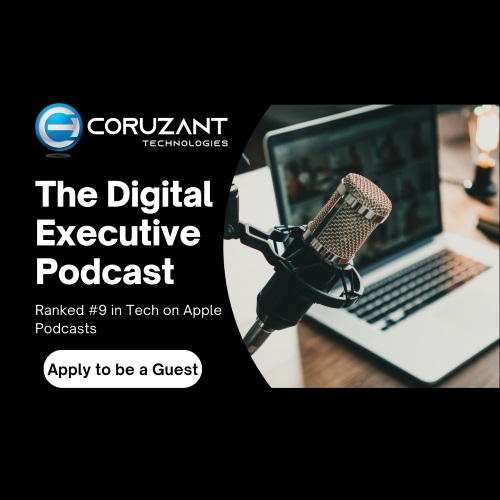Chris Piche Podcast Transcript
Chris Piche joins host Brian Thomas on The Digital Executive Podcast.
Welcome to Coruzant Technologies, Home of The Digital Executive podcast.
Brian Thomas: Welcome to The Digital Executive. Today’s guest is Chris Piche. Chris Piche is a computer scientist and technology entrepreneur born and raised in Canada. He is an expert in distributed networking, scalable video, and computer vision technologies.
Chris has developed technologies and products, including AT&T TV, BlackBerry Video, Polycom Video, and Stun/Turn/Ice. He has also been awarded Best of Internet World, Canada’s Top Young Leader, and Top 40 Under 40. Chris is now the founder and CEO of Smarter AI, the leader in AI cameras and enablement software.
Well, good afternoon, Chris. Welcome to the show!
Chris Piche: Thanks for having me back, Brian.
Brian Thomas: Absolutely. Love doing this. It’s been about a year now, but I appreciate you jumping back on making the time. And again, I know you, you’re a globe trotter. You travel the world and you’re hailing out of Dubai. Today, but I again, appreciate you making the time with the time zone changes.
So, Chris, jumping into your 1st question. As the founder of Smarter AI, what inspired you to start the company, and what do you see as the biggest opportunities and challenges in the AI camera and enablement software market?
Chris Piche: Well, I was inspired to start the company because. You know, I saw an opportunity similar to the opportunity in smartphones about 10 years earlier.
So, if you go back about, it’d be 12 years ago. Now. You know, we were all walking around with our Nokia, Ericsson, Motorola, BlackBerry phones. And thanks to a couple of enabling technologies, 3G networks and you know, low powered touch screens, it became possible or feasible to make smartphones.
And, of course, Apple was the 1st company to figure out the product market fit, and smart phones have now completely, you know, completely transformed our lives. And I, I think mostly for the good. And so about 4 or 5 years ago. I, you know, I saw I started to see cameras in a similar way.
There are, you know, millions of legacy cameras around the world, all recording video on disks and displaying the video on screens. But a lot of valuable data in there, but mostly that data wasn’t being looked at. And I saw that there were a couple of enabling technologies on the horizon. So, edge AI chips.
And know, high speed 5G wireless networks. And I thought that in the same way that a couple of technologies have made smartphones possible. That these technologies would make AI cameras possible, and I thought in the same way that. Apple developed iOS and the app store. And figured out the product market fit through.
No, through their software platform. I thought that the same thing was going to happen in the camera market. So basically, I set out to build the, you know, iOS and the app store of AI cameras.
Brian Thomas: Love that. And Chris, we talked about this before, but you’ve always had a vision of kind of what’s next and you’ve jumped in.
And like I said, you’ve kind of made that big bet on, on this and you certainly have done well with that. So, I appreciate the backstory on that. And Chris, with the rapid advancement of AI and machine learning, how do you foresee their integration with scalable video and computer vision technologies? Impacting various industries.
Chris Piche: Well, I’m going to, I’m going to focus on the industry that you know, that smart area is focused on, which is transportation. And I think we’re going to see 3 big changes in transportation as a result of. Or machine learning and cameras and video.
So, the first, 1 that we’ve already started to see a little bit is autonomous driving. So self-driving cars. The second, that we’re going to see. Is we’re going to see a huge increase in transportation safety. So, you know, a lot of the audience may not know this Brian, but, um, distracted or complacent driving, you know, such as texting and driving.
You know, is now responsible for killing more people than even drunk driving. It’s a huge problem. And it’s, of course, it’s growing all the time. But thanks to cameras and computer vision we’re able to put safety systems in place to remind drivers or coach drivers to put the phone down so that along with, you know, with other driver coaching technologies is starting to rapidly increase transportation safety and not only for you and I, as drivers, but for everyone as, as road users. And thirdly, and this is, you know, thinking a couple of steps ahead.
Once we see, once we have enough deployment of autonomous driving and, and driving safety technologies, one of the extra benefits that we’re gonna get for free as a result of those two things – Is elimination of congestion, so no more traffic jams, and obviously that’s going to have the biggest impact or the biggest benefit.
On the biggest cities, whether it’s Los Angeles or Mexico City, or even in Dubai, where I am today, the, the traffic is, it’s starting to get pretty bad.
Brian Thomas: That’s just amazing seeing how machines can enable better safety, less congestion, all the above. It’s just, it’s amazing. And I’m, and I’m glad you highlighted that texting because people.
And I see this just with even the newer vehicles that we have that have some of the assisted driving you know, where the brake light comes on or something automatically, I just see people getting more and more lax about their safety because they feel like, well, I’m in a vehicle.
That’s now telling me. It’s going to help me out. Right? And I think people lean on that too heavily. So, I can’t wait till we get to that. Perfect place where we can reduce the number of safety accidents down to zero. It’ll be, it’ll be a while, but, but I do appreciate your insights on that. And Chris, in your opinion, why is autonomous driving 10 times safer than human drivers?
And what is the industry doing to restore the public’s trust in autonomous driving?
Chris Piche: So, we have a lot, we actually have some very good data to support that, Brian. So, the N.H.T.S.A., the National Highway Transportation Safety Association. Has been tracking and publishing for years, even for decades the, the frequency of crashes on American roads.
And it’s been very consistent. It’s always around. 1 crash for every 500,000 miles driven and I think if you know, if you do the math you know, you can work it out that every person on average will be involved in 2 or 3 crashes during the course of their lifetime. Tesla, of course, in conjunction with their full self-driving and their Tesla insurance program.
Have been publishing similar crash rate statistics. Across their entire fleet of vehicles, but also across the subset of their vehicles that are equipped with full self-driving. And they published the most recent update 1 or 2 weeks ago, and I think they were down to 1 crash about every 7M miles.
So, you know, running the numbers Tesla equipped with, with full self-driving is about 14 times less likely to be involved in an accident than than an average American vehicle.
Brian Thomas: Thank you. That’s some amazing statistics. And I know there’s a lot of leaders out there in this industry, like Tesla that.
Are really striving to make driving much safer at the same time, being a little bit more autonomous, which I know gives some people some pause, but I really think that is important to people start learning more about it and adapting to the changes that are coming. So, I appreciate that and Chris, the last question of the day for you here, what are your long-term goals for smarter AI and how do you plan to stay ahead of the curve in such a fast pace and competitive industry?
Chris Piche: Yep, so a couple of things you know, number 1, our long-term goals are to eliminate transportation fatalities and transportation injuries. And how we’re going to get there. Yeah, is you know, taking the, the, the data that we collect from our, from our cameras today. And feeding that back into our machine learning or computer vision models, you know, we’re continuously retraining those models.
And over time you know, as our camera deployment grows, and as the as the precision of our models grow. We’re able to do a better and better job of discouraging or eliminating unsafe driving habits, like texting, like tailgating, et cetera.
Brian Thomas: Thank you. I’m glad that we kind of focused on the safety of autonomous driving safety of humans and machines on the roads today.
I think safety is a big part of that. And I’m glad that kind of the focus of the podcast was on that today. So, I appreciate that, Chris. And Chris, it was such a pleasure having you on again. And I look forward to speaking with you real soon.
Chris Piche: Thanks for having me again, Brian.
Brian Thomas: Bye for now.
Chris Piche Podcast Transcript. Listen to the audio on the guest’s podcast page.











